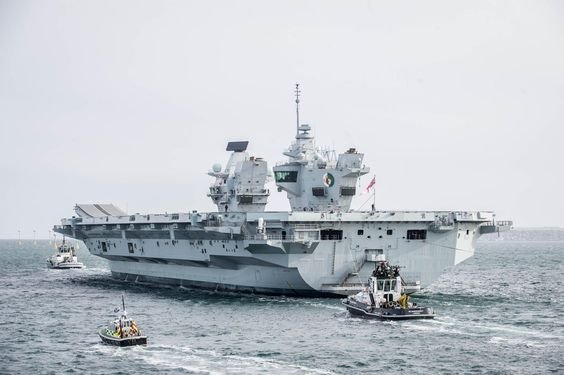Introduction to Carrier Strike Groups (CSGs)
Carrier Strike Groups (CSGs) serve as the backbone of modern naval power, projecting strength and versatility across the world’s oceans. Imagine a self-sustaining floating fortress, brimming with advanced technology, aircraft, and skilled personnel—all working in harmony to accomplish complex military missions. This powerful assembly plays a crucial role in national defense and international diplomacy.
As global tensions rise and geopolitical landscapes shift, understanding what drives these formidable formations has never been more essential. From their historical roots to their current operational capabilities, exploring Carrier Strike Group reveals much about how nations navigate today’s intricate security challenges. Buckle up as we dive into the world of CSGs—their purpose is far more significant than you might think!
History and Evolution of CSGs
The concept of Carrier Strike Groups (CSGs) has roots dating back to the early 20th century. Initially, navies relied heavily on battleships for power projection. However, with advancements in aviation technology during World War I and II, aircraft carriers began to emerge as vital assets.
As naval warfare evolved, so did the composition of CSGs. The post-war era saw a significant shift toward integrating multi-role aircraft and support vessels into these groups. This evolution allowed for greater flexibility in mission profiles.
During the Cold War, CSGs became essential components of deterrence strategies. They showcased a nation’s ability to project force globally while maintaining rapid response capabilities.
In recent decades, technological innovations have further reshaped their operations. Enhanced surveillance systems and precision strike capabilities have transformed how CSGs engage in conflicts today.
Components of a CSG
A Carrier Strike Group (CSG) is a formidable naval force, comprising several key elements that work in concert. At its core lies the aircraft carrier, which serves as the heart and command center of the group. This massive vessel hosts numerous aircraft ready for various missions.
Surrounding the carrier are guided-missile destroyers and cruisers. These ships provide essential protection against aerial threats while also engaging surface targets when necessary. Their advanced radar systems enhance situational awareness, ensuring comprehensive defense capabilities.
Submarines play a crucial role within a CSG as well. Silent and stealthy, they gather intelligence and can launch surprise attacks on enemy vessels or land-based installations.
Logistics support ships ensure that the strike group remains operational over extended periods by supplying fuel, ammunition, and provisions. Together, these components create a dynamic force capable of executing diverse military operations across vast ocean expanses.
Roles and Responsibilities of a CSG
Carrier Strike Groups (CSGs) play a crucial role in modern naval operations. Their primary mission is to project power and ensure maritime security across vast distances.
The flagship, often an aircraft carrier, leads the group. It serves as a floating base for air operations and command coordination. The crew on board operates advanced technology to manage both offensive and defensive strategies.
Air wings are integral to CSGs, providing air superiority through fighter jets and surveillance drones. These aircraft can respond swiftly to threats or support ground forces during conflicts.
Supporting vessels like guided-missile destroyers protect the carrier from aerial attacks while maintaining anti-submarine capabilities. Submarines within the group add another layer of stealth and firepower, making CSGs formidable adversaries at sea.
Each component works together seamlessly to execute various missions ranging from humanitarian assistance to combat operations, showcasing their versatility in naval warfare.
Examples of CSG Missions
Carrier Strike Groups (CSGs) have been pivotal in various military missions across the globe. One notable example is Operation Enduring Freedom, where CSGs provided essential air support and logistics in Afghanistan post-9/11.
In 2017, the USS Carl Vinson led a CSG during tensions with North Korea. The group showcased its power through joint exercises and deterrence operations, signaling U.
S. commitment to regional stability.
Humanitarian assistance also falls under CSG missions. After natural disasters like Hurricane Harvey in 2017, aircraft from carrier groups delivered aid supplies and medical assistance to affected areas.
Counter-piracy efforts are another critical role for CSGs. They patrol vital shipping lanes off the coast of Somalia, ensuring safe passage for commercial vessels while disrupting piracy networks.
These diverse examples illustrate how versatile Carrier Strike Groups are in responding to global challenges.
Importance of CSGs in Modern Warfare
Carrier Strike Groups (CSGs) play a pivotal role in modern warfare. Their ability to project power across vast oceans makes them invaluable assets for any navy. These groups can respond rapidly to emerging threats, whether in humanitarian crises or military conflicts.
The versatility of CSGs allows them to adapt their missions quickly. They serve not just as offensive units but also as platforms for deterrence and diplomacy. The presence of a CSG can stabilize regions by showcasing military strength without direct confrontation.
Moreover, the integration of advanced technology enhances their effectiveness. Modern aircraft carriers are equipped with cutting-edge systems that improve command and control capabilities, ensuring seamless operations among diverse vessels within the group.
CSGs facilitate joint operations with allied forces too, further amplifying their strategic importance on the global stage. This collaborative approach ensures that nations work together effectively when faced with common challenges or threats.
Challenges Faced by CSGs
Carrier Strike Groups (CSGs) operate in a complex and dynamic environment. They face numerous challenges that can impact their effectiveness.
One significant challenge is the advancement of anti-access/area denial (A2/AD) strategies employed by potential adversaries. These tactics aim to restrict the movement of CSGs, making it difficult for them to project power.
Cybersecurity threats also pose a major risk. As technology evolves, so do vulnerabilities within communication and navigation systems. A successful cyber attack could disrupt operations or compromise sensitive information.
Logistical support is another hurdle. Maintaining sustained operations at sea requires continuous supply lines, which are vulnerable to disruption from hostile forces or natural disasters.
Geopolitical tensions often create uncertainty regarding deployment locations and missions. This unpredictability complicates planning and readiness for CSGs in an ever-changing global landscape.
Future Implications for CSGs
As technology advances, the future of Carrier Strike Groups (CSGs) looks promising yet complex. The integration of artificial intelligence and unmanned systems will redefine operational strategies. CSGs may rely more on drones for reconnaissance and combat, enhancing their effectiveness.
Cyber warfare is another critical factor. Protecting digital assets within a CSG becomes vital as adversaries develop sophisticated hacking techniques. Future fleets will need robust cybersecurity measures to safeguard communication and operational integrity.
Moreover, environmental concerns are shaping naval operations. Sustainable practices in shipbuilding and energy use could become standard to address global climate challenges.
Geopolitical shifts influence how CSGs are deployed globally. New partnerships may emerge while existing alliances evolve in response to regional threats, requiring agile adaptations in strategy and structure for these formidable groups.
Components of a Carrier Strike Group
A Carrier Strike Group (CSG) is a formidable naval formation, crucial for modern military operations. At its core lies an aircraft carrier, serving as the centerpiece of power projection and versatility.
Surrounding the carrier are various supporting vessels that enhance operational capabilities. Destroyers and cruisers provide air defense, while submarines offer stealthy surveillance and strike options.
The air wing aboard the carrier includes fighter jets, reconnaissance planes, and support aircraft. This diverse array ensures dominance in both offensive and defensive operations.
Each component works together seamlessly to create a cohesive fighting unit. The synergy among ships enhances mission success rates during deployments around the globe.
With these interlocking elements, CSGs remain a vital asset for any navy seeking to maintain strategic superiority on the high seas.
The Role of a Carrier in the Group
The aircraft carrier serves as the heart of a Carrier Strike Group (CSG). It is not just a ship; it’s a floating airbase, projecting power across vast distances.
Equipped with advanced technology, the carrier houses and launches various aircraft. These planes are crucial for both offensive and defensive operations. They can engage enemy forces or provide support to ground troops.
Furthermore, carriers enhance strategic flexibility. Their mobility allows them to respond quickly to emerging threats anywhere in the world. This adaptability makes them invaluable in crisis situations.
The presence of a carrier often acts as a deterrent against potential adversaries. Nations recognize the strength that comes from having an operational CSG nearby.
Within the group, the carrier coordinates missions effectively among all vessels and aircraft involved. Its role goes beyond combat; it fosters joint operations and enhances overall mission success.
Importance of Air Wings in Carrier Strike Groups
Air wings are the backbone of a carrier strike group. They bring unmatched versatility and striking power to naval operations. Comprised of various aircraft, these wings can execute a range of missions from air superiority to ground attack.
The fighter jets provide essential cover for the fleet, ensuring that enemy aircraft cannot penetrate the defense perimeter. This capability allows other vessels in the group to operate with increased safety and confidence.
Moreover, surveillance planes enhance situational awareness by gathering intelligence over vast areas. Real-time data collected is vital for strategic decision-making during operations.
Helicopters add another layer of functionality, enabling troop transport and search-and-rescue missions. Their ability to operate close to shore expands the reach and effectiveness of carrier strike groups significantly.
In modern warfare, where rapid response is crucial, air wings ensure that CSGs remain agile and ready for any challenge they may face on the high seas or near coastlines.
Supporting Ships and Submarines in the Group
Supporting ships and submarines play a crucial role within a carrier strike group. They enhance the group’s operational effectiveness by providing essential capabilities that complement the aircraft carrier’s air power.
Destroyers, frigates, and cruisers operate alongside the carrier to ensure protection against potential threats. They are equipped with advanced radar systems and missile defense technologies, safeguarding the entire group from air and naval attacks.
Submarines add another layer of stealthy reconnaissance. These underwater vessels gather intelligence without being detected, allowing for strategic advantages during missions. Their ability to launch cruise missiles extends the strike group’s reach far beyond its visible assets.
Logistical support ships also contribute significantly by replenishing fuel, ammunition, and supplies at sea. This capability allows carriers to maintain extended operations without returning to port.
Together, these supporting elements create a comprehensive force capable of executing diverse missions across various terrains while ensuring mission success in modern warfare scenarios.
Operational Capabilities and Missions of Carrier Strike Groups
Carrier Strike Groups (CSGs) are dynamic entities designed for multifaceted military operations. Their operational capabilities range from power projection to deterrence and humanitarian assistance.
At the heart of a CSG is the aircraft carrier, serving as both a launch platform for air missions and a floating command center. This allows them to operate far from home shores while maintaining air superiority.
The integrated air wing enhances these capabilities, enabling diverse missions such as reconnaissance, strike operations, and electronic warfare. These formations can swiftly adapt tactics based on mission requirements or emerging threats.
Supporting vessels like destroyers and submarines amplify their effectiveness by providing anti-aircraft defense and anti-submarine warfare capabilities. Together, they create a formidable force capable of responding to various crises around the globe at a moment’s notice.
Current Use and Future Outlook for Carrier Strike Groups
Carrier strike groups are currently at the forefront of naval power projection. They play a pivotal role in maintaining global security and responding to crises worldwide. Their flexibility allows them to operate across various environments, from humanitarian missions to combat operations.
As geopolitical tensions rise, the relevance of carrier strike groups becomes increasingly evident. Nations recognize their capability for deterrence, rapid deployment, and sustained presence in critical regions.
Looking ahead, advancements in technology will shape the future of these groups. The integration of unmanned systems and advanced weaponry could enhance operational efficiency while minimizing risks.
Moreover, environmental considerations may influence how these fleets are designed and operated. Sustainability initiatives might become essential as navies aim to reduce their carbon footprints.
Carrier strike groups will continue evolving alongside military strategies and international relations dynamics. Their adaptability ensures they remain a cornerstone of maritime security for years to come.
Conclusion: The Vital Role of Carrier Strike Groups in Military Operations
Carrier Strike Groups play a pivotal role in modern military operations. They combine the power of naval aviation, surface ships, and submarines to project force wherever necessary. This integration allows for rapid response to crises and supports various missions from humanitarian assistance to combat operations.
The strategic importance of CSGs cannot be overstated. They serve as floating airbases, extending the reach of national defense far beyond territorial waters. Their versatility ensures that they can adapt to changing threats while maintaining readiness at all times.
As global dynamics shift, Carrier Strike Groups will continue to evolve. Advances in technology will enhance their capabilities, making them even more formidable deterrents against potential adversaries.
Understanding the structure and function of these groups reinforces their significance within naval strategy today. With ongoing developments in warfare tactics and technologies, CSGs are likely to remain critical components of maritime security strategies well into the future.







